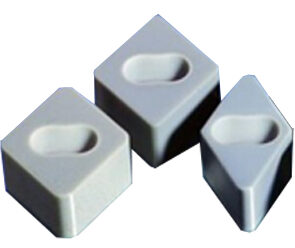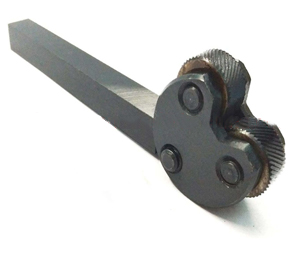Lathe Cutting Tools: Different Types of Tools for Turning

Lathe cutting tools are indispensable in the field of machining and manufacturing. These tools, which perform cutting operations on a lathe machine, shape and modify metal, wood, and other materials into precise specifications. Understanding the different types of lathe tools and their applications not only enhances efficiency but also ensures quality in the finished products.
Types of Materials for Lathe Cutting Tools
Lathe cutting tools are specialized tools used in turning operations on a lathe machine. They are classified based on various factors, including the type of material from which they are made. Each material offers different benefits and is suitable for various machining conditions, tool life, and workpiece materials. Here are some common types of materials used for lathe cutting tools:
-High-Speed Steel (HSS) Tools
Description and Properties: High-Speed Steel (HSS) tools are renowned for their durability and versatility. They can withstand higher temperatures without losing their temper, which allows for faster machining speeds compared to traditional carbon steel tools.
Common Applications: HSS tools are commonly used for general turning operations, threading, and other tasks where sharp edges and fine finishes are crucial. They are particularly favored in custom job shops for their adaptability.
-Carbide Tools
Advantages over HSS: Carbide tools, made from a mixture of carbon and tungsten, are significantly harder than HSS and maintain their edge for longer periods. This makes them ideal for high-volume production environments where tool changeover times can affect productivity.
Varieties and Uses: There are various grades of carbide tools designed for different machining operations, including finishing, medium, and roughing cuts. The choice of carbide type depends on the material being machined and the specific requirements of the task.

-Ceramic Tools
Benefits in High-Speed Machining: Ceramic tools excel in high-speed machining contexts where high temperatures are generated. They offer excellent wear resistance and can achieve higher cutting speeds than both HSS and carbide tools.
Limitations: However, ceramic tools are more brittle and require careful handling to avoid chipping or breaking during operation.

-Cermets
Properties: Made from ceramic particles bonded with metallic binder, offering a good balance of hardness and toughness.
Applications: Suitable for finishing and semi-finishing of steel and cast iron. Cermets provide superior finish quality and wear resistance.

-Diamond Cutting Tools
For Precision and Ultra-Hard Materials: Diamond cutting tools are the pinnacle of precision and are used when machining ultra-hard materials or when a very high-quality surface finish is required.
Cost Considerations: While offering unparalleled performance, diamond tools are also the most expensive, making them suitable for specialized applications where cost is secondary to performance.

-Cubic Boron Nitride(CBN)
Properties:CBN (PCBN) is a material with a hardness second only to synthetic diamond
Applications: Ideal for cutting hard materials like hardened steels, cast irons, and superalloys. Commonly used in automotive and aerospace industries for precision work.

Types of operation for Lathe Cutting Tools
Lathe cutting tools can also be categorized based on the operations they are designed to perform. Each type of operation requires tools with specific shapes, angles, and properties to efficiently execute tasks while maintaining tool longevity and workpiece quality. Here are some common categories of lathe cutting tools based on the operations they perform:
-Turning Tools
Purpose: Used for the basic cutting and shaping of the workpiece.
Types: Includes roughing tools for bulk material removal and finishing tools for achieving a smooth surface finis
-Facing Tools
Purpose: Specifically designed for cutting along the end face of the rotating workpiece, typically to create a flat surface.
Types: Similar to turning tools but typically have a different orientation to the workpiece.
-Boring Tools
Purpose: Used to enlarge holes or cylindrical cavities made in the workpiece.
Types: Boring bars and heads, which may vary in size and design based on the depth and diameter of the hole being machined.

-Threading Tools
Purpose: Designed to cut threads on the inside (internal threading) or outside (external threading) of a workpiece.
Types: Include taps and dies for manual threading and thread milling cutters for use on CNC lathes.

-Parting and Grooving Tools
Purpose: Used to cut a part off from the rest of the workpiece or to create grooves.
Types: Thin, sharp blades for parting and wider blades for grooving, often made from materials like HSS or carbide for durability.

-Knurling Tools
Purpose: Employed to create a textured pattern on the surface of a workpiece for improved grip.
Types: Rollers that press against the workpiece to form the textured pattern.

-Form Tools
Purpose: Used to create specific shapes in a single pass, often for decorative or functional features.
Types: Custom-made to the shape of the desired feature, requiring precise engineering and manufacturing.
Types of structural design for Lathe Cutting Tools
Lathe cutting tools can also be categorized based on their structural design, which influences their functionality and suitability for various machining operations. Here’s an overview of lathe cutting tools distinguished by their structural differences:
-Solid Tools
Structure: Made from a single piece of material, typically high-speed steel (HSS) or carbide.
Use: Commonly used for general turning, facing, and other standard lathe operations. Solid tools are durable and easy to sharpen.
-Brazed Tools
Structure: Consist of a cutting tip, usually carbide, brazed onto a steel shank.
Use: Offer the hardness of carbide at the cutting edge while maintaining the toughness of steel in the shank. They are cost-effective but can be difficult to re-sharpen once the cutting edge wears out.
-Indexable Tools
Structure: Feature a replaceable cutting insert, which can be rotated or replaced when one edge wears out. The body of the tool is usually made of steel.
Use: Extremely popular in industry due to their convenience and cost efficiency, as they allow for quick changes of the cutting edge without needing regrinding.
-Clamped Insert Tools
Structure: Similar to indexable tools but use a clamp mechanism to secure the cutting insert.
Use: Provide a secure hold for the insert, making them suitable for heavy-duty operations and reducing the risk of insert movement under high cutting forces.

-Multi-Point Tools
Structure: Equipped with several cutting edges that can be used in sequence.
Use: Efficient for operations requiring multiple cutting actions, such as threading or grooving, where consistent tool performance over multiple points is beneficial.
-Tipped Tools
Structure: Have a small tip of a hard material, such as diamond or cubic boron nitride (CBN), attached to the tip of the tool.
Use: Ideal for precision cutting of hard or abrasive materials where extreme hardness and wear resistance are required.
Types of Feed Direction for Lathe Cutting Tools

-Right-Hand Tools
Feed Direction: These tools are fed from left to right.
Usage: Right-hand tools are the most common and are used for operations where the tool starts cutting near the chuck and moves towards the tailstock. They are typically used for general turning and threading.
-Left-Hand Tools
Feed Direction: These tools are fed from right to left.
Usage: Less common than right-hand tools, left-hand tools are used for operations that require cutting in the opposite direction—starting near the tailstock and moving towards the headstock. This is useful for specific machining setups and part geometries.
-Neutral Tools
Feed Direction: Neutral tools are capable of cutting in both directions.
Usage: They are especially useful for operations such as parting or grooving where the direction of feed might change frequently. Neutral tools are versatile and can be applied in various machining contexts where directional flexibility is needed.
Feed Direction: Neutral tools are capable of cutting in both directions.
Usage: They are especially useful for operations such as parting or grooving where the direction of feed might change frequently. Neutral tools are versatile and can be applied in various machining contexts where directional flexibility is needed.
Considerations for Feed Direction in Tool Selection
- Surface Finish and Geometry: The direction of the cut can affect the surface finish and the dimensional accuracy of the workpiece.
- Chip Evacuation: Proper tool orientation helps in effective chip evacuation, which is crucial for maintaining tool life and workpiece quality.
- Tool Wear: The direction of feed can influence how forces are distributed on the tool’s cutting edge, affecting wear patterns and tool life.
Please Note: There are many different lathe cutting tools for various uses. It’s best to talk to a CNC machinist or contact Sundi Tools to find the right one.
How To Select The Right Lathe Cutting Tool?
Selecting the appropriate lathe cutting tools involves several key factors to ensure efficient, accurate, and cost-effective machining. Here’s a straightforward guide to help you make the right choice:
Understand the Material of the Workpiece:
- Different materials require different types of cutting tools. For example, carbide tools are excellent for hard materials like stainless steel, while HSS (High-Speed Steel) is better suited for softer materials like aluminum.
Determine the Machining Operation:
- Identify the specific operation you need to perform, such as turning, facing, threading, or grooving. Each operation may require a different tool geometry and type.
Choose the Right Tool Material:
- Common materials for lathe tools include:
- HSS: Versatile and cost-effective, suitable for low to medium precision work.
- Carbide: Known for its durability and ability to handle high speeds, ideal for hard materials and high precision.
- Ceramic: Best for high-speed machining of hard materials.
- CBN and Diamond: Used for ultra-hard or abrasive materials.
- Common materials for lathe tools include:
Consider Tool Geometry:
- Tool geometry affects the machining process and finish. Key aspects include the cutting angle, rake angle, and relief angle, tailored to the type of operation and material hardness.
Factor in Speed and Feed Rates:
- Ensure the chosen tool can handle the feed rates and speeds required for your specific operations. This compatibility influences tool wear and quality of finish.
Machine Compatibility:
- Check that the tool can be properly mounted and accommodated by your lathe. Compatibility includes shank size, tool post, and clearance.
Look at Coatings:
- Coated tools, such as those with Titanium Nitride (TiN), can offer increased durability and performance, particularly in challenging conditions.
Consult Experts:
- When in doubt, seek advice from experienced machinists or technical representatives from tool manufacturers. They can provide valuable insights based on your specific machining requirements.
By carefully considering these factors, you can effectively select lathe cutting tools that will perform well with your materials and machining processes, ultimately improving productivity and product quality.








